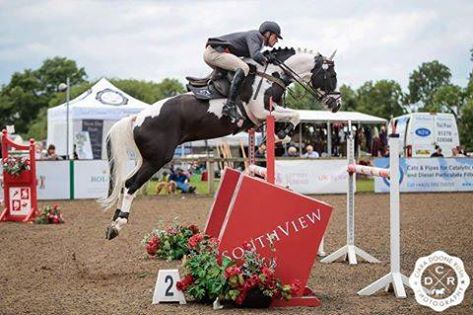Horsebox Maintenance
Breaking down on the motorway in the pouring rain, with one or more horses in a lorry or trailer isn`t anyone`s idea of fun. Unfortunately, it can and does happen and whether you are travelling to a local show or venturing further afield, a simple breakdown can quickly turn into a nightmare - particularly if the horses in transit are young, or do not travel well.
So, the next time you are busy checking over your horse or pony, spare a thought for the horsebox or trailer in which he has to travel. Photocopy this easy-to-follow checklist and pin it up in the tack room or on your noticeboard at home - it will help keep your horsebox (and your horse) in tip top condition:
- Make sure your lorry or trailer is serviced annually, including a thorough check on the brakes.
- Power-wash the outside and underside regularly, especially after use
- Make sure the box or trailer is taxed and insured and that the lights and indicators are working correctly.
- If your lorry or trailer has a wooden floor, check it regularly for signs of rotting - reports of floors giving way while horses are in transit are not uncommon and can result in serious injury!
- Occasionally remove floor matting or bedding, power-wash inside and allow to dry thoroughly before replacing.
- Regularly check the tyres for signs of wear and ensure that tyre pressures are correct.
- Never use a single axle trailer to tow a horse.
- Ensure the towing hitch is the correct height for the trailer and that the trailer can be towed level, to prevent uneven tyre wear.
- Always carry a fully charged mobile phone with you - even on short journeys. Make sure you carry the emergency helpline number for your breakdown/recovery company, vet and insurance company.
- Make a date in your diary to check your box or trailer every month.
- Remember - your horse`s safety depends on you!
Before you set off...
- Check that the indicators and lights are working on your Horsebox or towing vehicle and trailer and ensure that the ramp, doors and coupling are securely fastened.
- Make sure the trailer brake is off, the jockey wheel is in the raised position and the safety chain is securely attached.
- Make sure that the combined weight of your horse and trailer does not exceed the safe towing limit for your vehicle - if in doubt, check with your vehicle and/or trailer manufacturer.
- Check your spare tyre is in working order and fully inflated.
- Make sure the registration number on the back of the trailer is the same as the vehicle towing it.
Drive carefully...
- Move off slowly and allow plenty of time for your journey.
- Don`t cut corners - allow room for your vehicle to turn.
- Drive smoothly and thoughtfully, avoiding sudden braking and jerky manoeuvres - your horse cannot see where it is going and is therefore unable to prepare itself for sudden movements.
- Use your mirrors and make sure you are aware of what is happening on the road ahead of you at all times.
- Control your speed and observe the speed limits for your vehicle.
- Remember - if you passed your driving test after January 1997, you now need to pass a separate test to a tow a trailer weighing over 750kg.
Helpful hints on horsebox maintenance
The engine
- Check all oils (including hydraulic oil).
- Check all water levels (including windscreen washer) and that you have the correct concentration of coolant in your radiator for the weather conditions.
- Add an anticoagulant additive to the diesel to prevent the fuel from solidifying, particularly if extremely cold weather is forecasted.
- Clean water/sediment traps regularly and ensure that the filter is replaced.
- Change oil and fuel filters regularly,especially after high mileage or a long winter break.
- Start up and leave the engine running for 5 minutes before driving to allow the engine and pipes to warm up if turbo charger is fitted. After running the engine at high revs, allow it to tick over for a minute or so before switching off to allow turbo to cool.
- If your diesel engine overheats and loses cooling water, replace the water slowly, while the engine is running.
- Check all pulley belts are in good working condition.
Air brakes
- Pressurise brakes and check for leaks with the engine switched off.
- Check that all self-drain valves are operative and drain any condensation from the system.
- Prepare brakes by driving a short distance and applying the brakes intermittently, as when the brakes are cold they can often `bite` causing discomfort for horses in the rear.
- Ensure brakes are adjusted correctly and regularly.
Lights
- Check all internal lights as well as external. Include a check of warning lights (these bulbs tend to blow easily) and ensure a warning alarm is connected.
- Loading and Unloading lights should be fitted in winter.
- Unloading lights should clearly illuminate the ramp and surrounding area. Loading lights should illuminate the ramp as well as the container. Make sure lights point away from the horses to avoid glare.
Tyres
- Carry a useable spare. Ensure tyre pressures are correct.
- 16 "and 17 "tyres are becoming very difficult to replace as stocks are diminishing. Seek advice about replacing these tyres with a more common size of 17.5 " to avoid delays occurring if assistance is required.
- Check tyre condition, particularly if the vehicle has been left idle over the winter months, as they may have cracked on the rims as well as reduced in pressure.
- If buying a vehicle ensure that cross-plys and radials are not mixed on the same axle. Front tyres should always be new,rear tyres can be Precision Grade remoulds.
- If a trailer or small lorry, check that a serviceable jack and brace are carried. For horseboxes - check the inside tyres on the rear axle(s)as these often perish or go flat without being noticed.
- Lorries over 3.5 tonnes - carry a spare tyre without a spare wheel as assistance will be required to change the wheel anyway.
- Towing vehicles - Check rear tyres as trailers can flip onto their side if the towing vehicle suffers a rear tyre failure.



